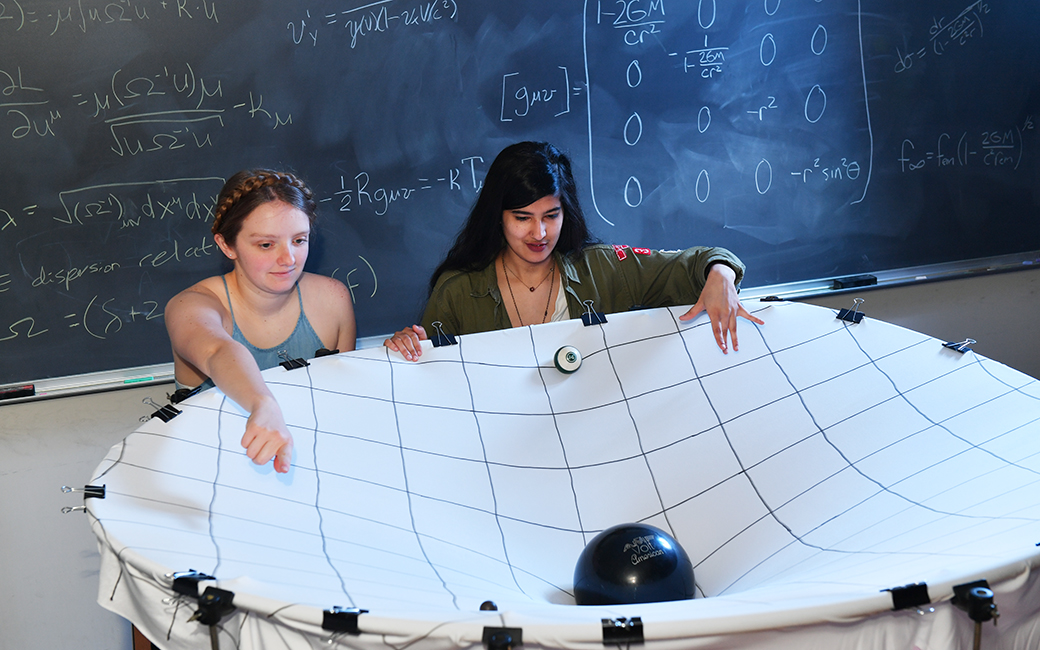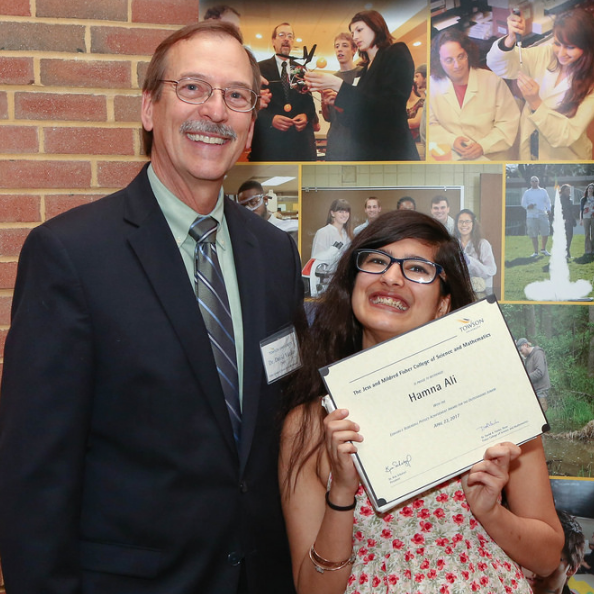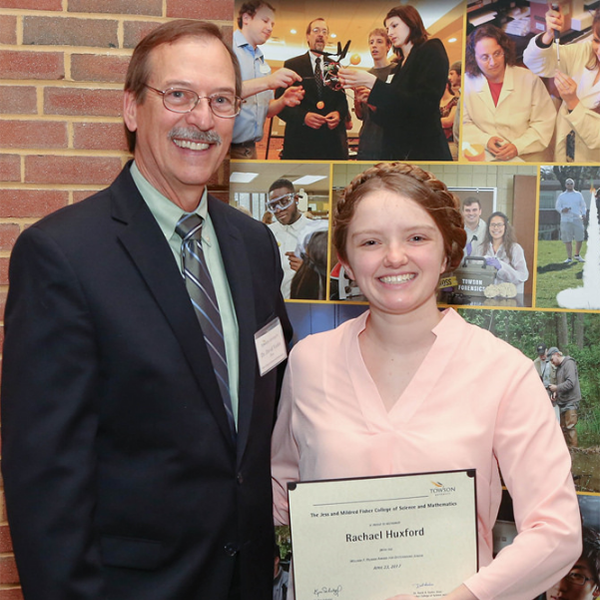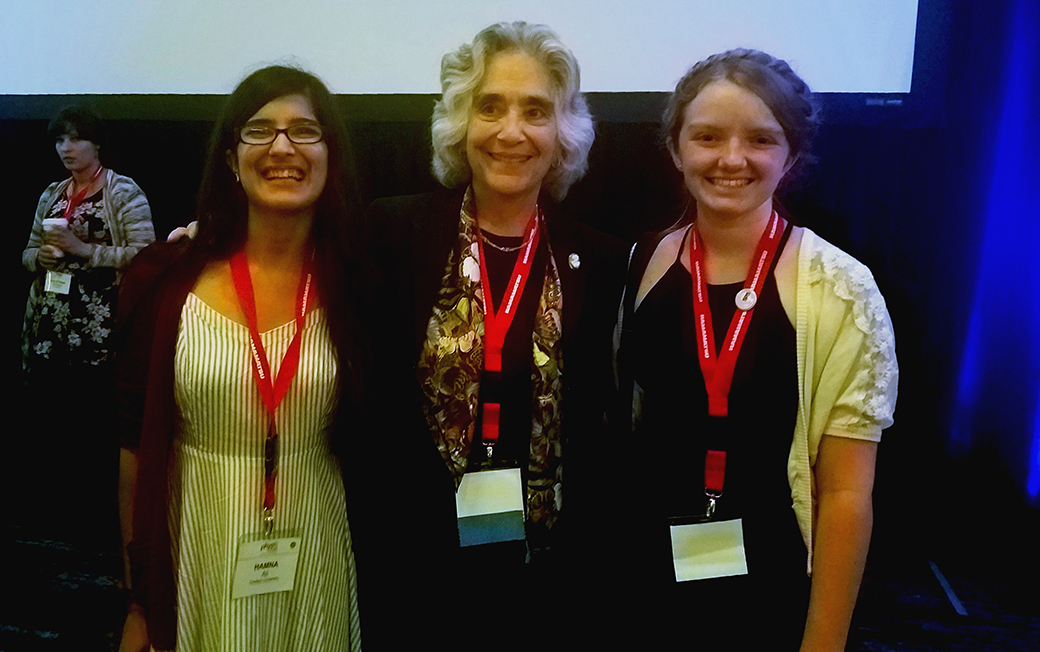TU physics majors are breaking the mold
TU's Rachael Huxford '18 and Hamna Ali '18 are poised to make an impact in the field of physics.
By Megan Bradshaw on August 7, 2017

If you Google “famous physicists,” 50 images pop up at the top of the browser window.
Two are women.
But Towson University’s Rachael Huxford ’18 and Hamna Ali ’18 are poised to make an impact in the field.
“They are truly curious about nature and its secrets. Such a simple thing, yet so few students have it,” said James Overduin, a TU physics professor who has co-supervised both women in research projects with colleague Thomas Krause. “I don't mean fleeting excitement about the latest news, but a deep and searching determination to understand. We're lucky to have them.”
Get Huxford and Ali in a room together and bad physics jokes and banter abound. But underneath the quick wit, the best friends’ sharp intellects shine through.
“I originally wanted to be a physics teacher, and research is what drew me into [physics] because in high school, I really thought all of physics had been figured out,” said Huxford. “But once you get past beginner physics, you realize there’s so much we don’t know. You can keep going forever and that’s fascinating.
“I think another thing, especially now that we’re in college, is NASA’s whole Mars mission thing. We all love it. If nothing else, the possibility of going to Mars keeps us going.”
Ali sighed in delight, making Huxford laugh.
“NASA should just make me the first person on Mars because they’ll checkbox every minority if they send me—first person, first woman, first person of color, first LGBT person, first left-handed person. Everything! It would be great!” joked Ali.
Both she and Huxford have secured coveted research positions for this summer.

Ali has received funding from TU’s Fisher College of Science and Mathematics to spend the summer at the Indiana University Center for Spacetime Symmetries (IUCSS) in Bloomington, Indiana. She was also invited to participate in an IUCSS workshop on mathematical physics with support from TU’s Department of Physics, Astronomy and Geosciences.
Her involvement with both these programs grew out of her research on extra dimensions with Overduin, which she presented at a conference at Indiana University in the summer of 2016. She was one of only a handful of undergraduates at that meeting, which was aimed primarily at professional scientists. The organizers were so impressed with her that they readily invited her back to work with them more intensively for this entire summer.
“We’re looking at collisions on an atomic and subatomic level and seeing if the standard model [of physics] works,” Ali said. “The whole model is based on an assumption about nature called Lorentz symmetry. We’re constantly trying to break it a little, so a lot of it is testing to see if something works within the parameters we have set for it.”

Huxford is working on gravitational wave detection at the Nationaal Instituut voor Kernfysica en Hoge-Energiefysica (NIKHEF) in Amsterdam, The Netherlands, through the University of Florida Gravitational Physics International REU program.
“I’m working with them to model equations of state for coalescing neutron stars and the gravity waves that come from them,” Huxford explained. “We’re trying to do all the science and the physics behind what that might look like and what the signals we get from them might look like. If we can model that, we can use that to filter through data and hopefully to find that maybe we’ve already seen one. Or once we do see one, it can tell us a lot about the physics of a neutron star and its equation of state and what makes them go boom.”
Huxford’s internship is part of a broader European effort to detect gravitational waves. Called VIRGO, this program is complementary to the American Laser Interferometry Gravitational-wave Observatory (LIGO), which shot to fame last year with the historic first detection of gravitational waves from colliding black holes, announced in February 11, 2016.
Related: From Legos to LIGO: alumnus Ryan Everett’s journey into physics history
The story of women in physics is not a happy one. Case in point is the students’ heroine, Jocelyn Bell Burnell, whom they met in person when they both presented their research at PhysCon 2016, the world’s largest conference for physics undergraduates, in San Francisco, California.

“She was heavily involved in the discovery of pulsars, which are big spinning neutron stars. But she didn’t get credit for it. The leaders of her team, who were all white men, got credit for it. They won the Nobel Prize and her name wasn’t on it,” explained Huxford.
Huxford mentioned how many female undergraduates attended the conference, noting how nice it was to finally have that many women—all as enthusiastic as they were—in the same place.
Twenty-five of TU’s 111 physics majors (as of spring 2017) are women, or about 23 percent. That is better than the national average, which peaked at 23 percent in 2002 and has been declining steadily.
Women dominate the leadership of TU’s Society of Physics Students. Under President Emileigh Shoemaker, the group recently won an outstanding chapter award from the national organization for the fifth year in a row. Overduin calls it “an incredibly vibrant group and one of the secrets behind our success as a department.”
Both women have one year left at TU in which to figure out the direction they want to take. Ali would like to end up at a particle accelerator lab working on big, collaborative, international projects. Huxford is clinging to her dream of becoming an astronaut despite an asthma diagnosis. She hopes her internship will help her decide if she wants to stick with gravitational waves or get a degree in engineering and work for NASA.
Whatever they decide, Overduin sees a bright future for the two.
“Hamna and Rachael both have strong mathematical ability, which is necessary to succeed in physics. But it isn't as rare as you might think. More rare, and more important, is perseverance, which both women have as well. But even that isn't the most important thing. The rarest and most important trait for success in physics is genuine passion for the subject, and that is where Hamna and Rachael stand out. It will carry them as far as they want to go.”